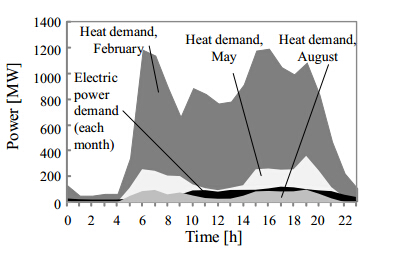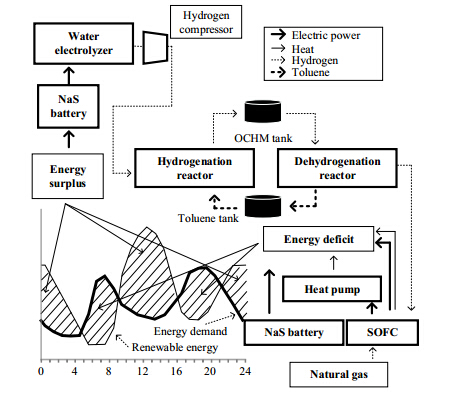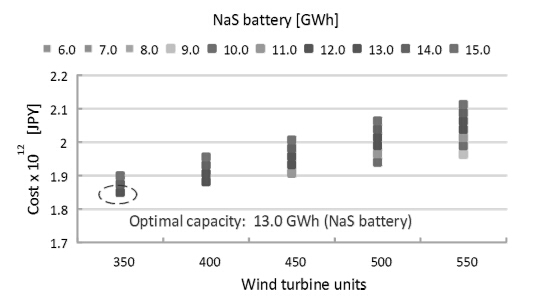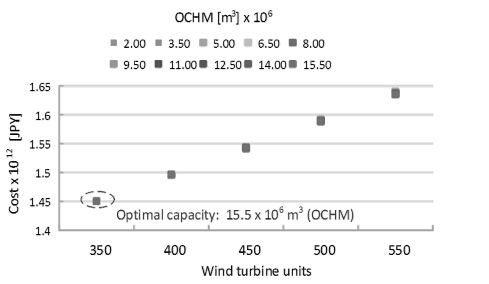1. Introduction
The Fukushima nuclear disaster in 2011 can be considered a tipping point in the history of Japanese energy policy development, particularly for the proposed strategies to reduce greenhouse gas emissions in the electricity industry [1]. Previously, the limited available space for the deployment of wind and solar farms in the country was considered an important limitation for the widespread use of renewable generation. The aesthetics of wind farms installed on mountains was also considered a serious obstacle, and offshore wind farms were regarded as too expensive. Nuclear power generation was considered to be the ideal generation type with high energy density (high energy generation per area needed for the plant), zero CO2 emissions, and reasonable generation cost. However, after the disaster, public opinion has been more receptive to the exploration of other alternatives for clean generation, particularly if they can replace nuclear power plants, which have a seriously damaged reputation. Currently, even with the higher costs of offshore wind generation, Japan is placing significant emphasis on offshore wind farm development, and a completely new direction has been chosen for the development of a clean and reliable power generation system [2].
Even though Japan has one of the best emergency systems in the world for natural disasters, the dimension of the 2011 disaster was so large that the system collapsed. Under these circumstances, the need for a continuous energy supply not only of electricity but also of fuel for transportation and heating became evident. This situation was aggravated by the Japanese fragmented power system and the interconnecting transmission lines with limited power capacities. Furthermore, the entire country is supplied in two areas with different frequencies, 50 Hz and 60 Hz, connected by a back-to-back conversion system with a limited power interchange capacity, which makes the free flow of power from one region to another difficult. Considering these facts, small or medium sized microgrids for specific areas are now considered to be a possible solution for continuous energy supply during abnormal conditions caused by a natural disaster. For instance, in the case of a centralized power system, damage in one of the main transmission lines can cause a complete shutdown of the electricity supply for a wide area. In this regard, local generation for local consumption is capable of keeping systems operational in the case of a catastrophe [3].
Rapid development and utilization of wind and solar energy have been taken place around the world in the past two decades [4,5]. Studies on the exploitation of natural resources in Kitami and other areas in Japan have been also performed in the past, before the disaster of 2011; the studies were mainly based on the utilization of wind and photovoltaic solar generation [6,7]. In the past three years, research focusing on microgrid development for local areas in Japan has considerably increased. Other studies analyzing the economic and environmental impact of storage system utilization on the development of microgrids have also been performed for Kitami [8,9]. Moreover, exploitation of the tidal currents of Saroma Lake, mainly based on the favorable conditions presented by the tidal currents in the two inlets connecting the Saroma Lake and the Okhotsk Sea, has been studied with more emphasis since the nuclear disaster in 2011 [10,11,12].
This paper proposes a new approach, a seasonal energy shifting strategy, which consists of the utilization of surplus energy from summer and spring during winter. This strategy enables the maximum exploitation of wind, solar, and tidal generation possible in a cold region with particular demand conditions and a high risk of being affected by a natural disaster. This work evaluates the most economical approach for the strategy and makes a cost-based comparison among several alternatives, including a conventional generation system. The work focuses on the development of a microgrid comprising the entire city, which contains the Saroma Lake, and which has an annual demand pattern characteristic of a cold region with high energy demands in winter and low demands in summer and spring. The proposed method is reinforced by the fact that Kitami is rich in wind, solar, and tidal resources, and abundant space is available for their deployment [13].
An optimal energy mix and infrastructure capacity, including renewable generation plants and storage systems, considering economic aspects, physical local conditions (available space, channel cross section, etc.), and the particularly high demand in winter, is obtained. In addition, a comparison with the cost of a conventional generation system is performed.
2. Methodology
2.1. System under study
2.1.1. Location
The proposed microgrid is designed to supply the total energy demand of Kitami City, located in the northern part of Hokkaido, Japan, as shown in Figure 1. In this figure, two of the 10 regions supplied by Japanese power companies, Hokkaido Electric Power Co., Inc. (HEPCO) and Tohoku Electric Power Co., Inc., are shown. Both regions are connected by a DC transmission line (indicated as double line). Currently, HEPCO supplies 100% of the electric energy to Kitami [14].
The city is located in a cold region. It has an annual demand characteristic of a high heat-to-power demand ratio during winter. The temperature reaches a minimum of −20 °C in winter and a maximum of 35 °C in the summer. Despite the low temperatures in winter, the city gets little rainfall and snowfall and has rich natural resources, such as wind, solar, and tidal power, that can be utilized for the generation of clean electrical energy. It is one of the richest areas in solar irradiation in Japan.
Moreover, it has open areas with good average wind speeds that can be exploited for the generation of electricity. Furthermore, the Saroma Lake tidal current speeds offer the possibility of exploitation of tidal generation[13].
2.1.2. demand characteristics
Because of the weather conditions that characterize the area, the heat demand represents a higher proportion of the total demand and is much higher in winter than in the summer and spring. The daily electric power and heat demand profiles are depicted in Figure 2 for three representative seasons: February (winter), May (spring), and August (summer). The electric power demand curves are overlapped for the scale shown in this figure. As can be seen in the figure, the heat demand in winter largely exceeds that of summer and spring. Because of this, the surplus energy during summer and spring can be utilized during the winter, as proposed in this work [15].
2.1.3. System configuration
Figure 3 depicts the system configuration with its different components. The Saroma Lake is located in the northern part of the city where the tidal turbines are to be installed. The three types of renewable generation and the storage systems including the solid oxide fuel cell (SOFC) are shown in this figure.
2.2. Seasonal energy shifting strategy
The seasonal energy shifting method consists of storing surplus energy from a season with low demand for using it in a season with high demand , such as winter. In this work, the shifting is performed from summer and spring to winter.
In Figure 4, a representation of the city’s daily total demand and total supply from renewable generation (wind, solar, and tidal) is illustrated with the proposed storage system. The energy flow scheme for the operation of the proposed strategy is also shown. The flow of electric power, heat, hydrogen, and toluene are indicated by arrows of different patterns.
The energy surplus is stored in a sodium-sulfur battery (NaS battery). If there is a surplus of energy beyond the capacity of the NaS battery, the energy is sent to a water electrolyzer and hydrogen is produced. This hydrogen is then sent to a hydrogenation reactor by a compressor, and organic chemical hydride methylcyclohexane (OCHM) is produced and stored in a tank.
The energy deficit is supplied by the NaS battery. In case the amount of stored energy in the battery becomes zero, the energy deficit is compensated by the extraction of hydrogen from the OCHM using a dehydrogenation reactor and feeding the hydrogen to the SOFC. If the energy deficit is larger, hydrogen is obtained from natural gas and then supplied to the SOFC. To achieve seasonal energy shifting, the equipment capacity is set up considering that the supply of natural gas from June to November is equal to zero.
2.3. Method of analysis
The most economic option for renewable generation and storage systems is calculated using an objective function that considers the total cost of the project for a lifespan of 20 years.
Equation (1) represents the objective function for the economic evaluation of the system. It is composed of equipment cost (COSTEQ), operation and maintenance cost (COSTO&M), and CO2 cost (COSTCO2).
| COST = COSTEQ + COSTO&M + COSTCO2 (1) |
(1)
|
The variables in this equation include the amount of wind, solar, and tidal power to be generated, as well as the capacities of the NaS battery and the hydrogen storage by OCHM.
Equation 1 is solved by performing an hourly energy balance during one year and finding the corresponding annual costs for each of the three cases considered. The cases are selected based on the configurations of the storage systems as described in Section 2.4. These costs are then extrapolated for the remaining 19 years of the project and then discounted using a nominal interest rate of 8% [16] and an inflation rate of 2% [17] to find the total cost’s Present Value (PV).
For each of the three cases considered, the size of the storage systems and the number of wind turbine units are varied and the alternative with the lowest cost selected. Finally these costs are compared and the lowest of them selected as the best alternative. The outputs of the tidal and solar farms are considered constant and equal to their maximum possible capacity based on the physical condition in the area, 8.3 MW and 206 MW, respectively. Each wind turbine has a rated power of 2, 500 kW.
The costs of generation plants, SOFC, heat pumps, and storage systems, including reference numbers, are shown in Table 1.
Table 1. System component costs.
| Component | COSTEQ | COSTO&M | COSTCO2 |
| Tidal farm Power converter | 400, 000 JPY/kW [12] 110, 000 JPY/kW [12] | 25, 000 JPY/kW/year [18] | No CO2 emission |
| Wind farm Power converter | 210, 000 JPY/kW [8] 110, 000 JPY/kW [12] | 6, 000 JPY/kW/year [8] | No CO2 emission |
| Solar farm Power converter | 325, 000 JPY/kW [8] 110, 000 JPY/kW [12] | 150 JPY/m2/year (L and ) [8] 15%/year (Maintenance) [8] 3, 000, 000 JPY/year (Personnel) [8] | No CO2 emission |
| SOFC | 500, 000 JPY/kW [8] | 4.7 JPY/kWh/year [12] 15 JPY/KWh (Natural gas) [12] | 2, 500 JPY/ton CO2 [20] |
| Heat pump | 100, 000 JPY/kW [8] | 3, 100 JPY/kW/year [19] | No CO2 emission |
| NaS battery | 25, 000 JPY/kWh [8] | 200, 000 JPY/kW/year [8] | No CO2 emission |
| OCHM | 4, 820 JPY/ (m3/h) [8] | 18.8 JPY/kW/year [12] | No CO2 emission |
The efficiencies considered are as follows:
- Tidal and wind farms: 33.5%
- Solar farm: 20%, variable with temperature by 0.4 %/K
- NaS battery: 75%
- Storage by OCHM: 71% (water electrolyzer), 99% (hydrogenation reactor) and 85% (dehydrogenation reactor).
- The heat pump is considered with the COP indicated in [8].
The efficiency of the gas turbine was considered equal to 40% and that of the kerosene heater equal to 70%. The energy density of the kerosene is considered equal to 37MJ/L.
2.4. Storage systems considered
Three cases are analyzed: Case 1 consists of the system shown in Figure 4 with only the NaS battery and no hydrogen storage by OCHM. Case 2 consists of only hydrogen storage by OCHM and no NaS battery. Case 3 represents a storage system including both the NaS battery and hydrogen storage by OCHM. Here, the NaS battery adjusts the supply and demand in the short term due to its faster dynamics, and the hydrogen storage by OCHM acts as the seasonal energy shifting device.
3. Results
The results of the analysis for the three cases are shown in Figures 5, 6, and 7. For the three cases, the installed capacity of the solar farm and tidal farm are considered at their maximum possible capacity based on the available space and local physical conditions.
In Figure 5, for Case 1, the number of wind turbine units and size of the NaS battery are varied, and the alternative with the lowest cost is chosen. For this alternative the number of wind turbine units is 350, the capacity of the NaS battery 13 GWh and the minimum cost 1.85 × 1012 JPY.
For Case 2, the number of wind turbine units and size of the hydrogen storage by OCHM are varied and the alternative with the lowest cost is selected, as shown in Figure 6. The optimal size of the hydrogen storage by OCHM is 15.5 × 106 m3 and the number of wind turbine units is, as in Case 1, equal to 350. The minimum cost for this case is 1.45 × 1012 JPY.
Finally, for Case 3, the optimal capacity for the NaS battery is 0.2 GWh, whereas that for hydrogen storage by OCHM is equal to 14.5 × 106 m3, with a minimum cost of 1.48 × 1012 JPY, as shown in Figure 7. As in Cases 1 and 2, the number of wind turbine units is equal to 350.
A summary of the optimal solutions for the three cases are shown in Figure 8, indicating that the optimal alternative is Case 2. The costs of a conventional system are also shown for various costs of CO2 emissions.
The conventional system is assumed to be composed of electric power supplied by thermal power generation and heat supplied by kerosene boilers. As shown, for the optimal case (Case 2) to be as economically attractive as the conventional system, the price for the emissions per ton of CO2 must be in the range from 65, 000 to 85, 000 JPY.
Sensitivity analysis is performed and the results are shown in Figure 9. The rate or return and the unitary costs of the two storage systems (indicated as “Storage systems”), the unitary costs of the three renewable power plants (indicated as “Renewable generators”) and the unitary cost of the heat pump and the SOFC (indicated as “Other equipment”) are varied in ±25% and the effect in the minimum cost of Case 3 is analyzed. Case 3 is selected since its optimal cost is close the optimal general one (Case2) and because the NaS battery may be necessary for rapid demand -supply imbalance compensations.
As can be seen the variations in the rate of return and in the costs of renewable generators have a greater effect in the total cost of the system.
4. Discussion
The analysis presented in this paper focuses on the optimal cost of a system composed of wind, solar, and tidal generation, together with a storage system for a seasonal renewable energy shifting. The number of wind turbine units and the type of storage system are varied to assess the effects on the cost and to decide the optimal configuration for the storage system and the optimal installed capacity for the wind farm.
Two aspects of the evaluation method are worth mentioning:
1- Impact on the environment: The areas where the wind and solar farms are considered for installation are open spaces with little or no population. Studies on the possible effects on birds and other animals are not evaluated. Detailed studies on this issue can limit the application of the results presented in this work.
2- Short-term supply-demand balance: The generation-storage configuration of Case1, with only a NaS battery, is much more expensive than the Case 2 with hydrogen storage by OCHM. The cost of Case 3, on the other h and , is quite close to that of Case 2. In an electricity supply system, there is a need for an instantaneous balance between supply and demand ; otherwise, the frequency of the system can cross the allowed normal range. Case 3 may be considered as the optimal case because the fast dynamics of the NaS batteries can help in this regard. The need for the degree of participation of NaS batteries in the system to balance demand and supply depends on the characteristics of the power grid involved and has to be analyzed separately, together with other issues such as transient stability and voltage regulation in the entire system.
5. Conclusion
In this work, we performed a study on the most economical infrastructure for a microgrid supplied by wind, solar, and tidal power, for Kitami City, in a cold region in Japan. Because of the high demand in winter, the surplus of power from the summer and spring is proposed to be utilized in the winter, which is accomplished by a seasonal energy shifting strategy with the application of the most suitable storage system.
We considered three types of storage system configurations and evaluated the cost of the total system by varying the number of wind turbine units and maintaining the capacities of the solar and tidal farms at their maximum values. The maximum capacities were determined by taking into account the available space and physical conditions in the area of installation.
According to results, from a strictly economic point of view, the case containing only hydrogen storage using OCHM as the energy storage device is optimal. The cost of the case containing a combination of the NaS battery and hydrogen storage by OCHM is higher because of the inclusion of the more expensive NaS battery. However, to balance the demand and supply in a power system and avoid the deterioration of the system’s frequency, this case may be necessary. A more detailed study including the instantaneous energy balance that affects the system’s frequency should also be performed based on the characteristics of the power grid.
Also, we found that the cost of a conventional system composed of thermal units and kerosene heaters was cheaper. The cost of the CO2 emissions is a key aspect to be taken into account. In addition, factors that cannot be translated into monetary values, such as the effect on human health, safety of the energy supply during cold seasons, and the presence of catastrophic events, have to be taken into account. Finally, uncertainties about the policies regarding the promotion of renewable energy and to what extent nuclear power can recover its participation in the Japanese system also have to be taken into account for a more precise and complete study in this regard.
Conflict of Interest
All authors declare no conflicts of interest in this paper.









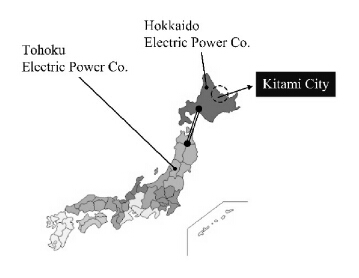
 DownLoad:
DownLoad: 